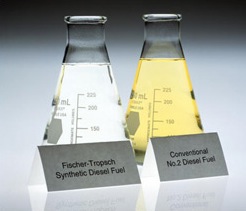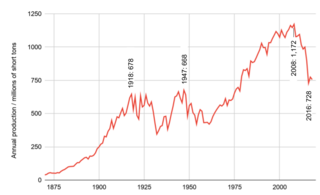
Coal is a combustible black or brownish-black sedimentary rock, formed as rock strata called coal seams. Coal is mostly carbon with variable amounts of other elements; chiefly hydrogen, sulfur, oxygen, and nitrogen. Coal is formed when dead plant matter decays into peat and is converted into coal by the heat and pressure of deep burial over millions of years. Vast deposits of coal originate in former wetlands—called coal forests—that covered much of the Earth's tropical land areas during the late Carboniferous (Pennsylvanian) and Permian times.

Lignite, often referred to as brown coal, is a soft, brown, combustible, sedimentary rock formed from naturally compressed peat. It is considered the lowest rank of coal due to its relatively low heat content. It has a carbon content around 60–70 percent. It is mined all around the world, is used almost exclusively as a fuel for steam-electric power generation, and is the coal which is most harmful to health.

The Office of Price Administration (OPA) was established within the Office for Emergency Management of the United States government by Executive Order 8875 on August 28, 1941. The functions of the OPA were originally to control money and rents after the outbreak of World War II.

Coke is a grey, hard, and porous fuel with a high carbon content and few impurities, made by heating coal or oil in the absence of air — a destructive distillation process. It is an important industrial product, used mainly in iron ore smelting, but also as a fuel in stoves and forges when air pollution is a concern.
Independent agencies of the United States federal government are agencies that exist outside the federal executive departments and the Executive Office of the President. In a narrower sense, the term may also be used to describe agencies that, while constitutionally managed by the executive branch, are independent of presidential control, usually because the president's power to dismiss the agency head or a member is limited.

Critical infrastructure is a term used by governments to describe assets that are essential for the functioning of a society and economy – the infrastructure. Most commonly associated with the term are facilities for:

William Julian Usery Jr. was a labor union activist and U.S. government political appointee who served as United States Secretary of Labor in the Ford administration.
Unconventional oil is petroleum produced or extracted using techniques other than the conventional method. Industry and governments across the globe are investing in unconventional oil sources due to the increasing scarcity of conventional oil reserves. Unconventional oil and gas have already made a dent in international energy linkages by reducing US energy import dependency.

For most of the 20th century, the United States Bureau of Mines (USBM) was the primary United States government agency conducting scientific research and disseminating information on the extraction, processing, use, and conservation of mineral resources. The Bureau was abolished in 1996.

The National Energy Technology Laboratory (NETL) is a U.S. national laboratory under the Department of Energy Office of Fossil Energy. NETL focuses on applied research for the clean production and use of domestic energy resources. NETL performs research and development on the supply, efficiency, and environmental constraints of producing and using fossil energy resources, while maintaining their affordability.

The War Production Board (WPB) was an agency of the United States government that supervised war production during World War II. President Franklin D. Roosevelt established it in January 1942, with Executive Order 9024. The WPB replaced the Supply Priorities and Allocation Board and the Office of Production Management.

Synthetic fuel or synfuel is a liquid fuel, or sometimes gaseous fuel, obtained from syngas, a mixture of carbon monoxide and hydrogen, in which the syngas was derived from gasification of solid feedstocks such as coal or biomass or by reforming of natural gas.
The War Assets Administration (WAA) was created to dispose of United States government-owned surplus material and property from World War II. The WAA was established in the Office for Emergency Management, effective March 25, 1946, by Executive Order 9689, January 31, 1946.
The Federal Fuel Administration was a World War I-era agency of the Federal government of the United States established by Executive Order 2690 of August 23, 1917 pursuant to the Food and Fuel Control Act, managed use of coal and oil. To conserve energy, it introduced daylight saving time, shortened work weeks for civilian goods factories, and encouraged Heatless Mondays.

Coal mining in the United States is an industry in transition. Production in 2017 was down 33% from the peak production of 1,162.7 million short tons in 2006. Employment of 50,000 coal miners is down from a peak of 883,000 in 1923. Generation of electricity is the largest user of coal, being used to produce 50% of electric power in 2005 and 27% in 2018. The U.S. is a net exporter of coal. U.S. coal exports, for which Europe is the largest customer, peaked in 2012. In 2015, the U.S. exported 7.0 percent of mined coal.
Refined coal is the product of the application of a coal-upgrading technology that removes moisture and certain pollutants from lower-rank coals such as sub-bituminous and lignite (brown) coals and raising their calorific values. Coal refining or upgrading technologies are typically pre-combustion treatments and/or processes that alter the characteristics of a coal before it is burned. The goals of pre-combustion coal-upgrading technologies are to increase efficiency and reduce emissions when coal is burned. Depending on the situation, pre-combustion technology can be used in place of or as a supplement to post-combustion technologies to control emissions from coal-fueled boilers. A primary benefit of refined coal is the capacity to reduce the net volume of carbon emissions that is currently emitted from power generators and would reduce the amount of emissions that is proposed to be managed via emerging carbon sequestration methodologies. Refined coal technologies have primarily been developed in the United States, several similar technologies have been researched, developed and tested in Victoria, Australia, including the Densified coal technology developed to alter the chemical bonds of brown coal to create a product that is cleaner, stable, exportable and of sufficiently high calorific value to be a black coal equivalent.

The history of coal mining in the United States goes back to the 1300s, when the Hopi Indians used coal. The first commercial use came in 1701, within the Manakin-Sabot area of Richmond, Virginia. Coal was the dominant power source in the United States in the late 1800s and early 1900s, and although in rapid decline it remains a significant source of energy in 2019.
Synthetic fuels in the United States is an issue of rising importance due the crude oil prices, and geopolitical and economic considerations.

The War Food Administration was a United States Government agency that existed from 1943 to 1945. The War Food Administration was responsible for the production and distribution of food to meet war and essential civilian needs during World War II. It was a predecessor of the Farm Service Agency.

There are two types of coal found in Pennsylvania: anthracite and bituminous. Anthracite coal is a natural mineral with a high carbon and energy content that gives off light and heat when burned, making it useful as a fuel. It was possibly first used in Pennsylvania as a fuel in 1769, but its real history begins with a documented discovery near Summit Hill and the founding of the Lehigh Coal Mine Company in 1792 to sporadically send expeditions to the wilderness atop Pisgah Ridge to mine the deposits, mostly with notable lack of great success, over the next 22 years. The owners of this company were absentee management—reliant on teams of workers sent under a foreman to fell timber to build so called 'Arks', then mine coal around nine miles from the right bank Lehigh, then trek with mule loads to fill the boats for the trip down the rapid strewn Lehigh River,(Brenckman, p. 595-597) and then more than 60 miles (97 km) to Philadelphia docks on the unimproved often log choked Delaware River.(Bartholomew, p. 4)















